
North End adds Italian flavor to trail
BOSTON — There is a place where American Revolutionary War history and Italian culture come together.
It is a place where you can find some of the key sites that led to the American Revolution and, at the same time, find an ethnicity that made America its home, yet managed to keep its traditions alive and at the same time influence the place where it came to live.
This is the North End of Boston.
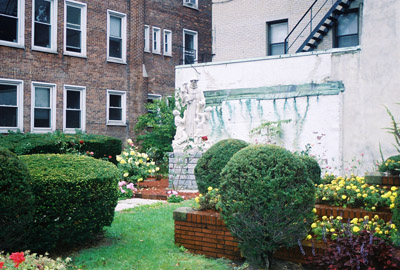 |
The courtyard garden of St. Leonard Catholic Church brings color to a North End Street (Photo by Tiffany Barranco). |
The North of End of Boston is full of Italian influence from a wave of Italian immigrants that came from Europe in the late 1800s.
When you first enter the North End through Hanover Street, you see green, white and red all over the place with pictures praising the Italians fourth World Cup win. It is clear that you are in the part of Boston known as Little Italy.
It is also clear that the neighborhood’s ties to the old country have not weakened in the past century.
On the corner of Hanover Street sits a small family owned restaurant, “La Famiglia Spagnuolo,” meaning the Spagnuolo family in Italian.
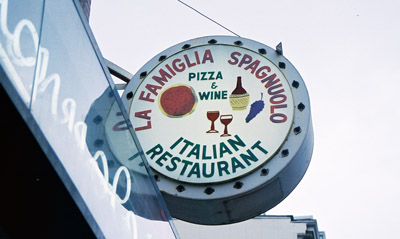 The restaurant is small, quaint and not too fancy and has a feel as if you have just entered Italy. There are Italian flags throughout the restaurant.
The restaurant is small, quaint and not too fancy and has a feel as if you have just entered Italy. There are Italian flags throughout the restaurant.
The walls on the inside are brick and have cast iron décor. Little white lights and bunches of plastic grapes are strung around the walls.
The tables have that traditional Italian feel with the flowers placed on the tables in empty wine bottles. The lighting is dim and there is Frank Sinatra playing in the background while “The Godfather” shows on the television screens.
It is said to have the best pizza and calzone in the North End. Other items that can be found on the menu include the traditional linguini carbonara, spaghetti, ravioli, and garlic breads.
Further down Hanover there is “Mike’s Pastry,” an Italian bakery that is known for its cannolis. They sell any kind of canoli imaginable with different fillings and flavors.
On any given day you can find lines that wrap around the store and out the door depending on what time it is. “Mike’s Pastry” has become so popular that they even ship their desserts anywhere in the country.
| The interior of the North End’s St. Leonard Catholic Church (Photo by Tiffany Barranco). | 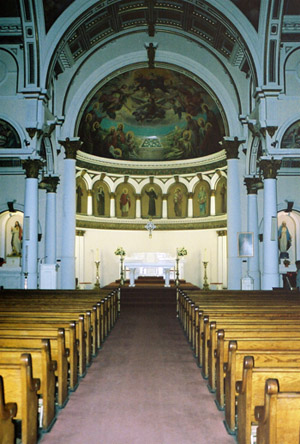 |
Further down on Hanover Street sits St. Leonard Roman Catholic Church.
St. Leonard was founded in 1873. It was built by the Italian immigrants and was the first Roman Catholic Church in New England.
To walk up to the doors of the church you first need to pass through the gates and then a beautiful garden that brings a sense of tranquility. The garden is full of roses and statutes of saints.
Long before the Italians immigrated to Boston however, the North End served as the home of sites that played an important role in the independence of the colonies from Britain.
One can get to all of the historical sites through the Freedom Trail. The Freedom Trail runs directly through the North End, stopping at several historical sites such as the Paul Revere House, Copp’s Hill Burying Ground and the Old North Church.
The Paul Revere House is a historical site that stands for the freedom we have today as a Country.
Paul Revere was the man that first warned the colonists that the British were coming.
The house was built in 1680 and purchased by the Revere family in 1770. It became the home of Paul Revere, his wife, and several children until the Revere family sold the house in 1800.
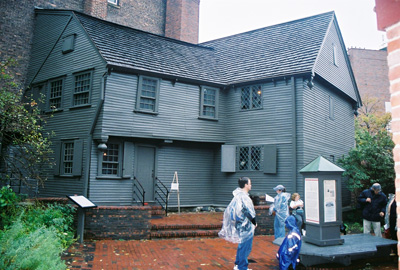 |
The Paul Revere House in the North End (Photo by Tiffany Barranco). |
The house today as it stands in the middle of the North End has some pieces of furniture that are said to be originals from the time that the Revere family occupied the house.
The floorboards on the house are all originals with the house that have been preserved. The part of the house known as the “hall” has furniture that represents a 1680s wealthy family. The bedroom has furniture that represents the later years of the Revere family.
Some drastic changes have taken place however from the time the house was first built. The kitchen for example was originally in the basement.
The house however was not always recognized as a symbol of American history. In the late 1890s Italian immigrants occupied the first floor and it was used as a market where they sold goods. Then in 1905 it was almost knocked down in an attempt to get the people living in it out.
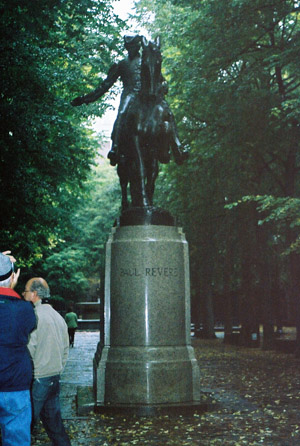 |
A statue of Patriot Paul Revere dominates the park between the Old North Church and Revere’s home on the Freedom Trail in the North End (Photo by Tiffany Barranco). |
Luckily, the house was saved from demolition and was restored. The first substantial restoration took place in 1908. The house was originally three floors, however the third story was taken off during the restoration.
A second restoration took place in 1950. At that time the “end wall” of the house was partially restored. Since then no major restorations have taken place.
Patrick Leehey, a historian at the Paul Revere House, says “about 200,000 people visit the house every year.”
“Federal and State governments give us grants to keep the house restored and opened. The members also contribute with their donations,” according to Leehey.
Another important site full of history in the North End found on the Freedom Trail is Copp’s Hill Burying Ground.
Copp’s Hill Burying Ground was the second burying ground established in Boston in 1660. It is a few blocks away from the North Church and was originally called the North Burying Place.
The oldest part of the cemetery is on the Hull Street entrance. There, most epitaphs are eroded and hardly legible.
| The historic Copp Hill Burying Ground on Hull Street in the North End (Photo by Tiffany Barranco). | 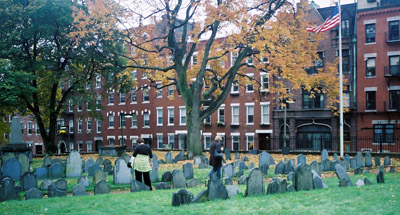 |
There are quite a few famous people buried at including Cotton Mather from the Salem Witch Trials.
The Old North Church is also an important historical site found on the Freedom Trail in the North End.
The Old North Church was built in 1723 and is the oldest standing church in Boston. The Old North Church is officially known as the Christ Church in the City of Boston.
The fame of the Old North came on the evening of April 18, 1775. That night, the church sexton, Robert Newman, climbed the steeple and held high two lanterns as a signal from Paul Revere that the British were marching into Lexington and Concord by sea.
That night at the Old North Church stirred up and began the American Revolution.
The North End is full of history, and not just American History. Just a few hours spent in the North End and you can get to know a little bit about two cultures: Americans and Italians.
| Shoppers make their choices in a North End Italian bakery (Photo by Tiffany Barranco). | 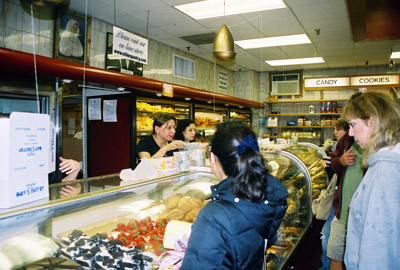 |
If You Go
La Famiglia
Address: 275 Tremont St.
Telephone: 617-292-2047
Mike’s Pastry
Address: 300 Hanover St.
Telephone: 617-742-3050
http://www.mikespastry.com
St. Leonard Church
Address: Corner of Hanover and Prince Streets
Telephone: 617-523-2110
http://www.catholic_church.org/stleonard/
Paul Revere House
Admission: Adults – $3
Seniors/Students – $2.50
Children (ages 5-17) – $1
Address: 19 North Square
Telephone: 617-523-2338
http://www.paulreverehouse.org
Hours: Open Daily, April 15 – Oct. 31 – 9:30 a.m. to 5:15 p.m., Nov. 1 – April 14 – 9:30 a.m. to 4:15 p.m., closed on Mondays in January, February and March, closed on Thanksgiving, Christmas Day and New Year’s Day.
Copp’s Hill Burying Ground
Address: Corner of Hull and Commercial Streets
Telephone: 617-635-4505
Admission: Free
http://www.cityofboston.gov/freedomtrail
Old North Church
Address: 193 Salem Street
Telephone: 617-523-6676
Admission: Basic Tour: $1 donation
Behind The Scenes Tour: Students/Child – $5, Adults – $ 8
http://www.oldnorth.com

Comments are Closed